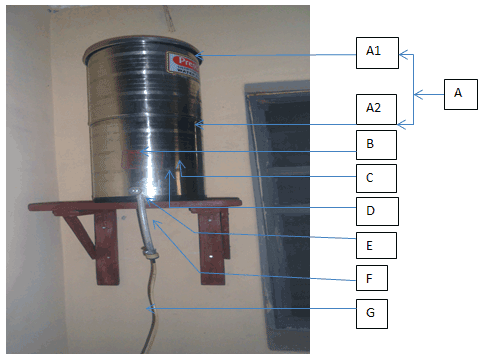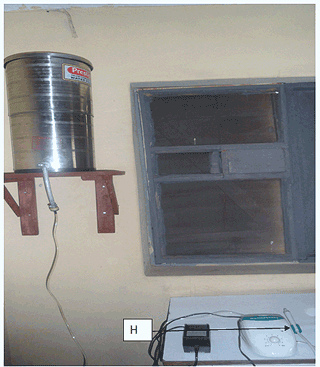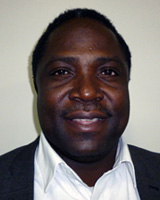Introduction
The primary healthcare (PHC) system has been adopted in many developing countries as a strategy in making health care available and accessible to a the largest population. This is especially so for people living in underserved communities because PHC is geared towards the prevention, early detection and treatment of common ailments. Primary health care utilizes appropriate and local technology in the delivery of care, often in the form of improvised devices, thereby providing healthcare services at an affordable cost. Primary health care also encourages intersectoral collaboration to ensure the most suitable and continued services are available. This ensures the widest possible distribution of the range of health care, including oral health services. Such an equitable distribution of health services assists oral health practitioners to cope with economic and technological barriers and become self-sufficient.
Periodontal disease and dental caries are the commonest chronic diseases worldwide; they lead to loss of school hours for children, and work absenteeism in adults which impacts on economic productivity1,2. They account for a high prevalence of toothache and tooth loss, especially in the adult population3-5. Both conditions are caused by plaque bacteria which accumulates due to poor oral hygiene practices. Progressive accumulation and solidification of the plaque result in calculus formation, which creates further damage to the tooth and its surrounding structures. Studies have reported that plaque and calculus are also reservoirs for the microorganisms implicated in the aetiology of several cardiovascular and respiratory diseases6-8. Removal of these tooth-destroying substances is essential for maintaining total health.
Removal of plaque, calculus and stains
Physical challenges to scaling and polishing include the presence of crevices, concavities and furcations, and bacterial invasion of tubules and soft tissues. However, plaque, calculus and stains can be removed effectively by mechanical scaling and polishing at a dental clinic. This procedure remains standard care for the non-surgical treatment of periodontal disease, and if properly performed it reduces the potential for bacterial re-colonization post-treatment9. Scaling and polishing is a proven protocol that improves clinical parameters through a reduction of the gingival index, plaque index, bleeding on probing and probing depth, and this encourages clinical attachment gain10. Scaling thoroughly cleanses the teeth in a way that cannot be accomplished by everyday dental hygiene procedures such as flossing and brushing. This is particularly important for older individuals and people who have disabilities that prevent them from brushing their teeth effectively, for the maintenance of basic oral hygiene is often a critical unmet need in people who cannot brush for themselves11-13. Instrumentation selection is crucial for eliminating toxins and promoting patient comfort while reducing fatigue in the clinician14.
Traditionally scaling and polishing has been accomplished using manual instruments such as curette, chisel and hoe scalers. However, ultrasonic scaling is becoming the preferred initial periodontal treatment in periodontal maintenance protocols due to improved patient and operator comfort3. Operators can select manual scaling, ultrasonic scaling or both. When both methods are used, the latter should be performed first to remove deposits grossly, followed by the use of a manual device for fine deposit removal. However, a study found no significant difference in the treatment outcomes between ultrasonic treatment alone or when it is followed by manual scaling15. Another study compared the effect on periodontal health of ultrasonic versus manual scaling of the lower second molar root surface, following surgical extraction of mesioangular lower third molars, and reported that pocket depth and depth of the infrabony defect were similar in both experimental and control groups16.
Ultrasonic scalers
Ultrasonic scalers have been found to be effective in removing subgingival plaque and calculus. Because it is difficult for patients to remove subgingival calculus and persistent stains, it is preferable for an annual visit to the dentist to augment personal oral hygiene measures. This motivates advocacy for public oral health services where ultrasonic scaling can remove difficult stains, such as those from tobacco chewing and smoking. Ultrasonic scaling is less fatiguing to operators, less time-consuming, requires less force and results in less tooth substance being lost8,9 than manual scaling. Copulos et al and Dragoo reported that ultrasonic scaling took approximately 34% and 29% less time than manual scaling17,18. It is more effective in areas with narrow and/or difficult root morphology, and provides lavage to the pocket during instrumentation. A timed debridement found that for a given time, ultrasonic scaling was significantly more effective than manual scaling19. Tactile sensitivity is also improved.
However, some risks are associated with ultrasonic scalers when the temperature increases at the tooth surface. The heat generated by ultrasonic scalers requires continuous use of great amounts of coolant, without which the increase in temperature could result in tooth surface, periodontal and pulpal damage20. The coolant must be cool enough to combat the heat generated, and its flow must be adequate. Walmsley et al reported larger additional areas of stained plaque removal where a water coolant was present than those produced by a non-water cooled tip21.
Oral health status of Nigerians
The majority of Nigerians live in semi-urban and rural communities where there are inadequate infrastructural facilities such as electricity, pipe-borne water and healthcare centres. Furthermore, the lack of electricity and pipe-borne water has made the provision of preventive and curative oral healthcare services such as ultrasonic scaling difficult in the few available oral healthcare centres. This may significantly impact on the general health and quality of life of community members. In Nigeria hand instruments and tooth-brushing are used to mechanically clean the teeth and these devices have achieved and maintained a good level of periodontal health. However, mechanical removal of subgingival microbial biofilms (bacterial plaque) is difficult. Effective subgingival plaque control is necessary for optimal wound healing and maintenance of gingival health22. To achieve intended clinical results and to meet patient needs, the combined use of ultrasonic and hand instruments is suggested.
Dental caries and periodontal diseases are the most frequently diagnosed oral diseases in dental clinics in Nigeria and their prevalence is increasing23-25. The prevalence of oral cancer is also said to be increasing in the Nigerian population. These diseases have resulted in tooth loss, toothache, low self-esteem, inability to perform daily activities and even death. Their increasing prevalence may be attributed to poor oral hygiene from inadequate and inefficient oral hygiene measures, and poor knowledge and utilization of preventive healthcare services.
Studies have revealed a high prevalence of poor oral hygiene among Nigerians, particularly those from lower socioeconomic classes26-28, which may be attributed to low awareness of oral hygiene methods and reduced access to cleaning agents, especially ultrasonic scalers.
Improvised source of water coolant for ultrasonic scaler
The innovative provision of ultrasonic scaling by improvising with available and adaptable technology can contribute to effective and efficient tooth cleaning in any setting. In addition, when combined with basic dental treatment and adequate oral health education (eg healthy dietary choices and effective fluoride use) such devices can improve the oral health of underserved and disadvantaged Nigerians who live in rural communities. A description of an easily assembled, innovative device follows.
The device
The improvised source of water coolant described in this report (Fig1) consists of a stainless steel water filter (Prestige; Mumbai, India) in an upper container which rests on a lower container that is connected to a tap. A rubber gasket beneath the lower container serves as the seat for the device on a wall-mounted wooden stand. The lower container's tap is connected by a clip to a 1 m length of 2 mm transparent hose, the other end of which is clipped to a motion filter. The motion filter is connected by a further clip to a 5.5 m length of transparent hose. The hose is then connected to the ultrasonic scaler (Fig2).
Water that is placed into the upper container passes through the filter candle into the lower container and then to the tap. The water then flows through the first hose into the motion filter which finely filters any particles from the water. The water then reaches the ultrasonic scaler via the final hose.

Figure 1: The improvised (A) source of water coolant with components:
(A1) upper container with internal filter candle, and
(A2) lower container connected to (B) tap; (C) rubber gasket;
(D) wall-mounted wooden stand; (E) 2 mm transparent hose x 1 m;
(F) motion filter and clip connection; (G) 5.5 m transparent hose.

Figure 2: The improvised source of water coolant connected to ultrasonic scaler (H).
Cleaning the device
This improvised source of water coolant can be used in PHC centres and community outreach programs where simple preventive and curative procedures form part of the program. The water container and filters should be cleaned at least once a week to remove sediment. All that is required is to disconnect the motion filter from the transparent hose by unscrewing the clip with a screw-driver. After disconnection, the water filter, water container and motion filter are washed with soap and an antiseptic solution. The water filter and motion filter are then left in a bowl containing antiseptic solution for 30-45 min. After this sterilization, the water filter and motion filter should be rinsed in a large bowl of clean water. The water filter is then replaced in the water container and the disconnected parts reassembled. Clean water drawn from a well or collected from boreholes is poured into the upper container and the device is ready to use again.
Success of the improvised source of water coolant for ultrasonic scaler to date
It is hoped that use of the improvised source of water coolant described for the ultrasonic scaler will make the modern way of plaque and calculus removal available to many, especially those in remote, rural and semi-rural communities who account for the majority of the Nigerian population. In Nigeria where plaque, calculus and stains have been removed manually, only a few dental clinics have the more efficient and effective ultrasonic scalers. The reason for this may be a lack of electricity and pipe-borne water. However, in clinics where electricity is produced from generators, even if pipe-borne water is scarce this improvised coolant source is available. Indeed, the device is currently being used in communities without a piped public water supply, and in some of these communities there is no well or borehole and little prospect of government-provided piped water to the health centre. In these cases water must be purchased from commercial water tankers. The challenges of operating dental clinics in these settings necessitated the invention described.
The cost of this improvised coolant device is a modest approximately US$150. This device is currently used to complement manual tooth cleaning with hand instruments in Primary Dental Clinics at Idikan in Ibadan and Igboora in Ibarapa, Oyo State, all outreach dental programs of the Faculty of Dentistry, University of Ibadan, Nigeria. The cost of scaling using hand instruments is $5 and the cost of ultrasonic scaling is set at $7, which is affordable for most patients. This encourages patients to opt for ultrasonic scaling rather than hand scaling.
Unpublished reports have shown after introduction of the device, patient presentation for professional tooth cleaning services has increased, and many patients prefer to have their teeth cleaned ultrasonically with the device. It has been observed that patients who had their teeth cleaned using ultrasonic scaling were excited about the use of this technology and informed others in the community about the treatment. In addition, awareness of the prevention of periodontal disease by modern, professional tooth cleaning is likely to increase in Idikan and Igboora. This improved awareness may also be due to the increasing number of oral health campaigns by dentists and dental students who visit these communities for their primary oral health care posting.
Finally, it can be reported that a patient whose teeth were cleaned manually some years prior to the use of the device with an ultrasonic scaler said, 'The ultrasonic scaler caused less discomfort' when compared with hand instrumentation. And a dentist who used the ultrasonic scaler stated that 'the device increased my efficiency when compared to manual scaling'.
Conclusion
This improvised source of water coolant fitted to an ultrasonic scaler is an innovation that will modernize effective plaque control for people in underserved communities and developing countries where there is no pipe-borne water. It will improve operator efficiency in tooth cleaning and patient compliance with treatment. This device, by design and functionality, is a perfect fit with the PHC delivery program in Nigeria because it can assist the provision of preventive and curative services in remote, rural, semi-urban and urban settings. The provision of this improvised source of water coolant for ultrasonic scaling, together with the use of hand scaling, especially in high risk patients, offers periodontal treatment options to improve oral health and reduce the incidence of oral diseases. However, oral health practitioners should emphasize the need for patients to continue regular, personal oral-hygiene measures such as tooth-brushing after professional tooth cleaning.
References
1. Selwitz RH, Ismail AI, Pitts NB. Dental caries. The Lancet 2007; 369(9555): 51-59.
2. Jin LJ, Armitage GC, Klinge B, Lang NP, Tonetti M, Williams RC. Global Oral Health Inequalities Task Group - Periodontal disease. Advances in Dental Research 2011; 23(2): 221-226
3. Saini R. Optical detection of dental caries. Chronicles of Young Scientists 2011; 2: 61.
4. Oginni FO. Tooth loss in a sub-urban Nigerian population: causes and pattern of mortality revisited. International Dental Journal 2005; 55(1): 17-23.
5. Petersen PE, Bourgeois D, Ogawa H, Estupinan-Day, Ndiaye C. The global burden of oral diseases and risks to oral health. Bulletin of the World Health Organization 2005; 83: 661-669.
6. Li X, Kolltveit KM, Tronstad L, Olsen I. Systemic diseases caused by oral infection. Clinical Microbiology Reviews 2000; 13(4): 547-558.
7. Kuo LC, Polson AM, Kang T. Associations between periodontal diseases and systemic diseases: a review of the inter-relationships and interactions with diabetes, respiratory diseases, cardiovascular diseases and osteoporosis. Public Health 2008; 122(4): 417-433.
8. Molly J, Wolf LF, Lopez-Guzman A, Hodges JS. The association of periodontal disease parameters with systemic medical conditions and tobacco use. Journal of Clinical Periodontology 2004; 31(8): 625-632.
9. Apatzidou DA, Kinane DF. Nonsurgical mechanical treatment strategies for periodontal disease. Dentistry Clinical North America 2010; 54(1): 1-12.
10. Socransky SS, Haffajee AD, Cugini MA, Smith C, Kent Jr RL. Microbial complexes in subgingival plaque. Journal of Clinical Periodontology 1998; 25: 134-144.
11. Kambhu P, Levy S. An evaluation of the effectiveness of four mechanical plaque removal devices when used by a trained care provider. Special Care Dentistry 1993; 13: 9-14.
12. Shaw M, Shaw L, Foster T. The oral health in different groups of adults with mental handicaps attending Birmingham (UK) adult training centres. Community Dental Health 1990; 7: 135-141.
13. Shaw M, Shaw L, Foster T. Correlation of manual dexterity and comprehension with oral hygiene and periodontal status in mentally handicapped adults. Community Dentistry Oral Epidemiology 1989; 17: 187-189.
14. Deshpande RG, Khan MB, Grenco CA. Invasion strategies of the oral pathogen Porphyromonas gingivalis: implications for cardiovascular disease. Invasion Metastastasis 1998; 18: 57-69.
15. Chapper A, Catao W, Oppermann RV. Hand and ultrasonic instrumentation in the treatment of chronic periodontitis after supragingival plaque control. Brazilian Journal of Oral Research 2005; 19(1): 174-178.
16. Pons-Vicente O, Valmaseda-Castellon E, Berini-Aytes L, Gay-Escoda C. Effect on pocket depth and attachment level of manual versus ultrasonic scaling of lower second molars following lower third molar extraction: a randomized controlled trial. Oral Surgery, Oral Medicine, Oral Pathology, Oral Radiology and Endodontology 2009; 107(3): e11-e19.
17. Copulos TA, Low SB, Walker CB, Trebllcock YY, Hefti AF. Comparative analysis between a modified ultrasonic tip and hand instruments on clinical parameters of periodontal disease. Journal of Periodontology 1993; 64: 694-700.
18. Dragoo MR. A clinical evaluation of hand and ultrasonic instruments on subgingival debridement. 1. With unmodified and modified ultrasonic inserts. International Journal of Periodontology Restorative Dentistry 1992; 12(4): 310-323.
19. Drisko CL, Killoy WJ. Scaling and root planning: removal of calculus and subgingival organisms. Current Opinion in Dentistry 1991; 1: 74-80.
20. Nicoll BK, Peters RJ. Heat generation during ultrasonic instrumentation of dentin as affected by different irrigation methods. Journal of Periodontology 1998; 69(8): 884-888.
21. Walmsley AD, Laird WRE, Williams AR. Dental plaque removal by cavitational activity during ultrasonic scaling. Journal of Clinical Periodontology 1988; 15: 539-543.
22. Committee of the American Academy of Periodontology. Position paper: Sonic and ultrasonic scalers in Periodontics, Research, Science and Therapy. Journal of Periodontology 2000; 71: 1792-1801.
23. Kubota K, Hollist NO, Olusile AO, Yonemitsu M, Minakuchi S, Watanabe H et al. Joint epidemiological longitudinal survey in Nigeria, especially in comparison with that of Japanese. Bulletin of Tokyo Medical Dental University 1993; 40(1): 59-78.
24. Adegbembe OA, el Nadeef MA, Adeyinka AA. National survey of dental caries status and treatment needs in Nigeria. International Dental Journal 1995; 45: 35-44.
25. Umesi-Koleoso DC, Ayanbadejo PO, Oremosu OA, Dental caries trend among adolescents in Lagos, Southwestern Nigeria. West African Journal of Medicine 2007; 26(3): 201-205.
26. Aderinokun GA, Lawoyin JO, Onyeaso CO. Effect of two common Nigerian chewing sticks on gingival health and oral hygiene. Odonto-stomalogie Tropicale 1999; 22: 13-18.
27. Okolo SN, Chukwu GA, Egbuonu I, Ezeogu FA, Onwuanaku C, Adeleke OA et al. Oral hygiene and nutritional status of children aged 1-7 years in a rural community. Ghana Medical Journal 2006; 40(1): 22-25.
28. Ayanbadejo PO, Savage KO, Jeboda SO. Awareness of periodontal diseases amongst Nigerian diabetics. Odonto-stomatologie Tropicale 2004; 27(105): 13-16.


